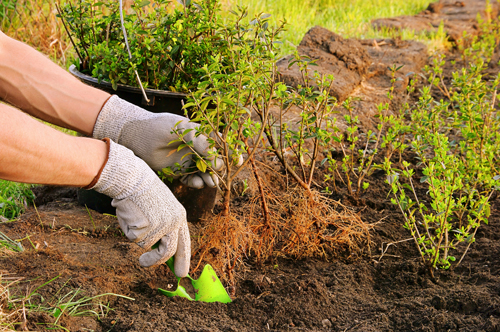
HEDGING
General Considerations – Care and Maintenance
Planting in soil:
Choose the right spot for your plant;
- Almost all fruiting/flowering plants need plenty of sunshine to produce good crops, so find an open sunny spot (there are a few exceptions such as Morello Cherry and Bilberry for shadier spots).
- Avoid frost pockets. Late spring frosts will do far more damage to flowers and embryo fruits if trapped in a hollow or against a solid fence. East-facing sites are also much more susceptible to frost damage – the rapid thaw caused by the rays of the early morning sun are far more damaging than a slow thaw out of direct sunlight.
- Allow enough space for each plant, specific information is available within the specific plant instructions.
- Soil types: Most flowering plants will thrive in most normal garden soils, though some do have specific requirements. Apples and pears for instance are not suited to very acid (peat-rich) soils, while blueberries will not last long on alkaline (chalky) soils. Most plants need soils to be reasonably well drained, raspberries suffer particularly badly if their roots sit wet over winter, being shallow-rooting they also need their soil to be kept moist in summer.
- If the “right spot” is along a wall or fence, pick a plant that can be espalier or fan trained, or a bush like a blackberry that needs the support of a fence or wall.
Ground preparation, staking and watering-in;
When you receive your tree / plant / bush soak the root ball in a bucket of water overnight. Ideally you should plant your tree / plant / bush the next day.
Improve soil structure by thorough digging before planting, ideally to a depth of about 45cm (18”) – two spades deep.
If possible, mix well rotted manure or compost into the top soil.
Dig a hole comfortably large enough to take the root ball, remove the pot or bag. Plant, ensuring the top of the root ball is level with the surrounding soil, or up to 2.5cm (1”) deeper.
For Blueberries, Bilberries, Cranberries and Lingonberries only, apply RootgrowTM Ericoid (available from Trees & More) directly to the roots before planting – this will help the plant to establish quickly.
For all other plants, apply RootgrowTM mycorrhizal fungi (available from Trees & More) for the same purpose.
Tread firmly and water-in thoroughly. Stake the plant and secure with a tree tie to prevent it rocking before the root system is established.
Potted plants:
These are ideally suited for small gardens and patios. The roots of the plants are in a smaller more confined space than they would be if they were in soil. As a result, more care is needed.
Water frequently in dry weather and make sure that the plant always has sufficient water. The plant will use up all the nutrients in the pot as the supply is limited by the compost volume, so feed a liquid feed every 1-2 weeks during the main growing season: May – August.
As the plant grows, repot your plant into fresh compost and prune the roots to stimulate fresh vigour every 1 or 2 years. Aim to replace at least a third of the compost.
Weeding & Mulching;
Keep the area around the plant free of weeds, particularly during the first year. An annual mulch of well rotted compost will greatly improve moisture retention and soil structure, it will also help suppress unwanted weeds.
Watering;
Keep the soil around the plant moist throughout the first growing season. In later years only water during prolonged dry spells, drenching thoroughly no more than once a week. One exception to this are figs, which are amongst the most drought-tolerant of plants. Container grown plants will need more regular watering and should never be allowed to dry out. Aim to keep the compost moist at all times, but do not leave standing in water or you risk drowning the roots. Figs are amongst the most drought-tolerant of plants when planted in the ground so should rarely be watered. If grown in a pot however they will still need regular watering.
Hedging
Planting
Plant your trees as soon as possible after receipt, allowing sufficient space for them to grow. Bush trees will grow 2.5-3.5m (8-12ft) in height and spread. Cordons should be restricted to 1.8-2.4m (6-8ft) in height and can be spaced 60-90cm (2-3ft) apart.
Pruning
To create a dense hedge, bushy from the ground up, the plants must be cut back hard to about 30-45cm (1ft-18”) above ground when they are planted. This encourages vigorous new growths from the base and helps establishment by initially reducing both wind rock and the amount of new foliage while the new roots are trying to grow.
Thereafter trim twice a year, in mid summer and late winter, or more often to create a neater more formal appearance. Use either garden shears, a hedge-trimmer or secateurs if you want to avoid unsightly partially cut foliage on larger leaved evergreens such as cherry laurel. In the early years remove about half the new growth each time, encouraging lots of new shoots to thicken the hedge as it increases in height. Once it has reached the desired height and spread remove almost all the new growth at each trim.
Vigorous spring-flowering shrubs such as Philadelphus (Mock Orange) should be cut back hard immediately the blossom finishes, usually in July. Remove most of the previous year’s growth, at least 75%. This will encourage lots of new growths that will set blossom buds later in summer to bloom the following spring. It will also prevent the shrub becoming leggy as it ages.
Should any of your hedging plants get out of control, i.e not be trimmed for several years, they can be restored to good order by being cut back hard in late winter to rejuvenate them, to within 45cm (18”) of the ground if necessary. This is not our recommended method of regular pruning and will almost certainly result in the loss of the next crop of flowers and/or fruits but they should all survive it.
Feeding
Most garden soils contain adequate nutrients for a typical hedge. Over-feeding encourages excessive growth which will require more trimming and may lead to more pest and disease attacks.
Pests & Diseases
Rabbits can be a problem during establishment, gnawing away the bark around the stems near the base in winter. If in doubt fit rabbit guards. If cattle and/or horses have access to the hedge soon after planting they will destroy it unless it is securely fenced off – about 2m (6ft) away.
Whitefly and woolly aphid (beech) are common pests, but not normally serious enough to warrant treatment.
We pride ourselves on giving our customers an excellent service, a wide choice of products and very competitive prices.
IF YOU CANNOT FIND WHAT YOU ARE LOOKING FOR PLEASE CALL:
MIKE 07958 174618
